The Birth of the Food and Drug Administration Alumni Association: "Once An FDAer, Always An FDAer"
Reader’s Note: Given its overall length, this document has been divided into two sections. For those of you interested only in a quick snapshot of the Association’s history, an overview is provided in Section I. For those of you “history buffs” who want the nitty-gritty details, Section II offers the full story of events leading up to creation of the FDAAA and its initial years of operation. Whichever you choose, we hope you find the document informative. One other point: the document is current as of November 2005. Every effort has been made to ensure factual accuracy and avoid editorial comment.
Introduction
Not every entity of the federal government has loyal alumni who have tried to keep in touch with each other and to follow, at least in the newspapers, the activities of their agency. In this sense, FDA is unique and blessed. Its culture and prominent presence in American society over the past century are unlike most agencies of our national government. And so, over the years, many informal social and work contacts have been maintained by interested alumni.
In 2000, two persons (one alumna and one employee) got the idea that a more formal organization of alumni would be a good idea. They involved others and obtained ideas for such a group. The effort soon snowballed. Enthusiastic endorsements were received from former and present FDA officials, including FDA commissioners.
From several sources, including current agency officials, came the idea that a proposed organization should be more than social. It could be, many felt, a resource for FDA – not only for ideas and for an institutional memory, but as a potential service organization and support group, especially in times of emergency, such as a terrorist attack.
In 2003, noting the saying, “Once an FDAer, Always An FDAer,” FDA announced it had signed a formal Memorandum of Understanding with the new Food and Drug Administration Alumni Association (FDAAA). By then, members were being enrolled from many states (and even Switzerland). A slate of officers was elected. Luncheon seminars were being held with interesting and challenging speakers. The FDAAA was on its way!
This document chronicles the journey to formation of the organization and its early life stages.
Section I. Historical Snapshot of the FDAAA
The following provides a shorthand review of the Association, from the day the idea was first hatched to final transformation into an actual organization.
- 1990’s – Establishment of e-mail-based FDA Alumni Network, a communications/information link to approximately 300 former agency employees; Network served as a forerunner to formal FDA alumni association.
- October 2000 – Idea of FDA alumni association first raised during visit by CDRH alumna and employee to NIST and serendipitous discussion with NIST alumni group member.
- December 2000 – Written proposal for FDA alumni organization pitched to FDLI president and vice-president who agree to help champion the idea.
- February-March 2001 – Fact-finding meetings with local area alumni associations associated with federal agencies and Congress revealed start-up successes and pitfalls.
- April 2001 – FDA alumni association concepts presented to past and current FDA leaders, receiving widespread endorsement.
- July 2001 – FDA employees and alumni join together to form a steering committee to debate feasibility and mission for a new association.
- January 2002 – Steering Committee obtains pro bono legal assistance from Washington, DC law firm.
- March 2002 – Preliminary “roll out” of the association with appointment of officers, Board of Directors, tiered membership structure and charter memberships.
- April 2003 – First Association-sponsored luncheon seminar in Gaithersburg, MD, featuring FDA leaders as guest speakers.
- July 2003 – Association by-laws adopted and incorporation papers filed in Maryland.
- August 2002 – First Board of Directors meeting.
- September 2002 – First written endorsement received from former FDA commissioner (all other commissioners and acting commissioners later followed suit).
- November 2002 – Publication of inaugural edition of “Connections”, the Association’s newsletter.
- December 2002 – Provisional tax-exempt status granted to the Association by the IRS.
- February 2003 – Association website unveiled on the Internet.
- March 2003 – FDA-FDAAAA Memorandum of Understanding signed, authorizing collaborative projects; Association code of ethics adopted to prevent misuse of Association membership.
- April 2003 – Public “roll-out” of Association at FDLI conference and initial FDAAA annual meeting, followed by part FDAAA exhibit at FDA Science Forum later the same month.
- May 2003 – First FDAAA nominations for FDA Distinguished Alumni Award.
- June 2003 – Exchange of letters between FDAAA and FDA proposing joint projects relating to agency centennial, international assistance and
- April 2004 – Second, more formal annual meeting featuring Paul G. Rogers as Association’s inaugural Harvey W. Wiley Lecturer and presentation of first FDAAA Volunteer of the Year award.
- July 2004 – Partnership agreement consummated with FDA on agency centennial observance.
- August 2004 – Association recruited by HHS and FDA leaders for regulatory assistance project with Hashemite Kingdom of Jordan.
Section II. History of the FDAAA: The Long Story
Chapter One: Genesis of the FDAAA
Sometimes in life, unexpected events shape destiny. A case in point is the Food and Drug Administration Alumni Association, Inc.
The notion of a formal association for FDA alumni first occurred on October 19, 2000 when Mr. Robert Eccleston, a staff member of FDA’s Center for Devices and Radiological Health, and Mrs. Kelly Sauer, a CDRH alumna, were visiting the Commerce Department’s National Institute of Standards and Technology in Gaithersburg, MD. They were there to make arrangements for an event at the NIST campus the following month to honor Mr. John Villforth, a former U.S. Assistant Surgeon General, CDRH Director, who was retiring after a long and distinguished public health career.
As they passed through the corridors of NIST’s main administration building, Eccleston and Sauer serendipitously spotted a meeting going on sponsored by the Standards Alumni Association (SAA). At that instant, the meeting’s organizer, Hans Osner -- himself a member of the SAA -- emerged from the meeting room and was introduced to the FDA visitors by their NIST escort. The man shared a few words about the SAA and offered to talk more at a later time if they wanted.
Moments after the brief exchange, Eccleston and Sauer mused aloud whether any kind of group similar to the SAA existed for FDA alumni or whether one had ever been attempted and if not, why not. They decided to investigate further.
In the weeks that followed, Eccleston and Sauer came up empty in their search for information or traces of any kind of an organization dedicated to alumni of FDA. Thinking they might be on to something, the two began brainstorming and swapping ideas. Just before Christmas 2000, they cobbled together their ideas in a white paper which they felt could be used as a catalyst to get other alumni talking and thinking about the possibility of creating such an organization.
Eccleston and Sauer next decided to float the white paper by John Villforth, the person who they had earlier arranged to have honored at NIST facility. They approached the former director of FDA’s medical devices and radiological health center for two reasons. First, they knew, having worked for him, that Villforth could be blunt and candid, as well as fair-minded and someone who liked to think creatively and outside the box and appreciated others who did the same. Given that, the two felt certain of getting an objective critique of their proposal. The other reason they sought Villforth’s gut reaction first was his own efforts while center director to foster interpersonal relationships through various functions and events, including a yearly social gathering of alumni who had worked in FDA’s radiological health program.
Late in December, the white paper reached Villforth, who at the time was president of the non-profit educational organization known as the Food and Drug Law Institute. Intrigued, he consulted his vice-president and former CDRH associate, Joseph Arcarese. After reading the proposal and agreeing it had possibilities, they suggested a face-to-face discussion with Eccleston and Sauer. The meeting occurred on January 8, 2001 at FDLI headquarters in Washington, DC. The foursome decided more fact-gathering was necessary to determine how the SAA got started, how it sustained itself and whether other groups associated with federal agencies existed from which they could get more insights.
The journey had begun.
Chapter Two: Learning From Others
Osner, the man from the SAA was contacted and his offer to talk more about the SAA experience was accepted. On February 9, 2001, the “FDA foursome” returned to the NIST campus where they met with several SAA member volunteers in a small basement office that doubled as a command post of sorts for the NIST alumni group.
The hours-long session produced a gold mine of information. The men from SAA regaled the four visitors with story after story about how the SAA got started, how NIST leaders became supporters of the SAA, how the organization functioned, and what was done to keep members engaged. SAA’s founding documents (including a Cooperative Research and Development Agreement – CRADA) and copies of publications were shared. So, too, was information about other local-area federal alumni organizations, including the National Institutes of Health, Social Security Administration (SSA), and the then-Health Care Financing Administration (HCFA) (now the Centers for Medicare & Medicaid Services). Armed with the information, the quartet from FDA made additional contacts, the first being the alumni association from NIH. On February 15, the four drove to the NIH Alumni Association’s off-campus offices on Old Georgetown Road in Bethesda, Maryland where they met a couple of part-time staffers, Harriett Greenwald and Mary Calley Hartman. Their experiences in running the organization largely mirrored those at the SAA with the notable exception that support from the NIH leadership was erratic and unpredictable. Still, the two women staff were upbeat and heartily encouraged the group from FDA to give it a go.
In the weeks following, the alumni groups associated with the SSA and HCFA were queried by phone about the mission and operational details of their respective organizations. Compared to the SAA and NIH groups, the two were somewhat less structured and seemed not to enjoy the degree of agency support found with the first two groups that were interviewed.
Taken together, the discussions with the four existing alumni associations were so beneficial and the enthusiasm of each about its existence so contagious that the foursome called other agencies to find out if more existed. Calls were placed to the Centers for Disease Control and Prevention, Environmental Protection Agency, Department of Transportation, Occupational Safety and Health Administration and Nuclear Regulatory Commission. Of these, only the NRC, it was learned, had a small, loosely-organized and largely social group of former employees that got together periodically.
Sounding Out Former FDA Leaders
Based on the positive experiences of other alumni associations, Villforth decided to “test market” the idea of an FDA alumni association. He phoned former commissioner, Dr. Jane Henney, then former acting commissioner, Dr. Mark Novitch; both gave the proposal a thumbs up. He then called several alumni to get their reaction. He spoke with Gerry Meyer, a former associate commissioner for administration and drugs center deputy director; Tony Celeste, a former member of FDA’s field investigations unit; Mary Doug Tyson, a former drugs center assistant director; and Burton Love, a past regional food and drug director. Each thought the idea reasonable.
Love was especially enthusiastic. Since the early-1990’s, he had managed what he dubbed the FDA Alumni Network, an e-mail communications link that kept over 300 alumni around the United States informed about the goings-on at FDA as well as the careers and lives of former colleagues. Love routinely streamed out the latest news on personnel, organizational and policy changes at the agency, retirement and death notices, and the like. He had also begun talking up the idea of a formal alumni organization with a number of former colleagues and had constructed an alumni website with help from a father-son duo – Ernie Carabillo II and Ernie Carabillo III – and David Link, the first head of FDA’s medical devices bureau who at the time was running a consulting business in Massachusetts.
On hearing Villforth’s idea of building on what Love had started to form a nationwide association, Love was immediately sold. The two men agreed to canvas Network subscribers on their interest in an association. Responses poured in, the majority of which were resoundingly positive.
Proponents of the FDA alumni association idea concluded that sufficient interest existed to warrant elevating the proposal to senior-level FDA officials.
Getting the Agency on Board
On April 9, Villforth, Sauer and Arcarese met with Dr. Bernard Schwetz, FDA’s Acting Principal Deputy Commissioner, in his 14th floor office in the Parklawn Building, and were joined by Dr. Linda Suydam, senior associate commissioner; Dr. Elizabeth Jacobson, senior science advisor; Ms. Patricia Foley from the administrative office; and field operations chief, Mr. Dennis Baker. In relatively short order, the assembled group envisaged an association as a resource that could be reflexively leveraged when public health emergencies and other critical situations struck and FDA was either short-handed or in need of seasoned experience and specialized expertise, of the kind alumni had in abundance. A consensus quickly emerged in favor of the proposal.
Schwetz was discernibly taken with it. Determined not to waste time, he suggested a formal working agreement between FDA and the association once it was formalized and got its sea legs. Others in room nodded their concurrence. As the discussion moved to what should be done next, Villforth recommended a steering committee comprised of alumni and employees to construct a framework and mission for the “still-on-paper” organization. Schwetz thought the idea a good one and, a few days later, wrote FDA’s senior program managers (then referred to as the Leadership Council) asking them to assign staff members to the committee, which he told them, would be co-chaired by Villforth and Love.
Buoyed by Schwetz’s ebulliently supportive response, Villforth and Love took their sales pitch on the road. The duo rallied support for an association at a leadership training program held a few weeks later in Rockville for FDA district directors and regional laboratory directors. Audience reaction was positive but guarded, with some individuals asking pointed questions about what an organization like what Villforth and Love were pitching could do for them. Later the same day, both men, flanked by Eccleston and Arcarese, sat down privately with Dennis Baker and Ed Esparza to talk out how field office staff could be given an equal stake in the ramp-up and operations of the new organization. Baker and Esparza underscored the need for inclusiveness if the goal was to establish an association with a truly national constituency. Doing so, they added, would also better assure delivery by the association on its pledge to help further FDA’s public health mission given the wide range of expertise of among field investigators.
Gaining Momentum
While efforts to raise awareness of and build support for the association continued, more information-gathering about other alumni groups was done. On May 24, Eccleston traveled to Capitol Hill for a pre-arranged meeting with the U.S. Association of Former Members of Congress and its executive director, Ms. Linda Reed. In reviewing the group’s history, Reed noted early failures that nearly caused its demise. Initially, she said, the association lacked purpose and a vision. It was, ostensibly, a forum only for social gatherings of its members – ex-politicians and former congressional staff members. Complaining that they should be getting considerably more for their dues than invitations to cocktail parties and fancy dinners, which most were well accustomed to doing on their own, members demanded an organization that served others, attracted young people to public service and enlightened fledging democracies and third world nations about America’s democratic form government. The bottom-line message was unmistakably clear, Reed told Eccleston: “give people a reason to join.”
The meeting with Reed marked the end of the initial phase of the FDA association build-up. Much had been learned about what worked in other organizations, what the pitfalls were in getting started, how to make an association self-sustaining and enduring and, most of all, how to give it an identifiable sense of purpose and the means to accomplish its mission. It was now time to apply what was learned to the groundbreaking work of the newly-established steering committee.
On July 18, 2001, the steering committee met for the first time at the Corporate Boulevard offices of CDRH in Rockville. Nearly two dozen people gathered, while others scattered about in Texas, Connecticut and Arkansas participated by phone. The group quickly got down to business, forming several working subcommittees. One, focused on membership, was to be led by Elizabeth Jacobson.
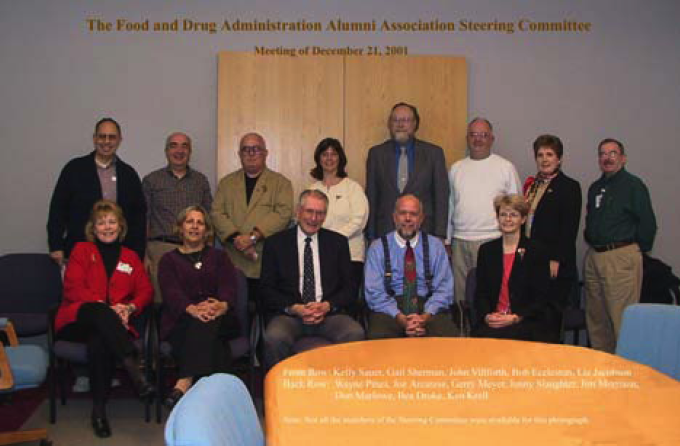
Front row (l to r): Kelly Sauer, Gail Sherman, John Villforth, Bob Eccleston, Liz Jacobson
Back row (l tro r): Wayne Pines, Joe Arcarese, Gerry Meyer, Jenny Slaughter, Jim Morrison, Don Marlowe, Bea Droke, Ken Krell
Another, chaired by Gerry Meyer, was charged to look at administrative support. A third was tasked with governance and legal and business affairs, with Mr. Fred Degnan, a former FDA attorney, in charge. (Degnan was succeeded son afterwards by Mr. William Vodra who, months later, turned over the chair to Bruce Kuhlik.)
An executive committee was also set up to oversee and coordinate the work of the various subcommittees and direct start-up activities. Members of the steering committee unanimously backed the proposal for a working arrangement with FDA, believing that a formal relationship with the agency would give the association much-needed legitimacy and a clear purpose for its existence. Committee members also felt that a collaborative relationship with FDA would help sustain and give stability to the new organization over the long term, as was evidenced in the case of the SAA and its partnership with NIST.
In a mere eight months, the FDA alumni association had moved from the concept stage to a bona fide start-up enterprise that was gaining traction daily. People around the nation had been successfully mobilized to transform the novel idea into a reality.
Shaken But Undeterred
Early in September, the Executive Committee convened its first meeting. Villforth and Love jointly presided over the group consisting of subcommittee chairs and Eccleston, Sauer and Arcarese as members-at-large. A sense of the momentum that was building was in the air. Each participant at the meeting was acutely aware that the proverbial snowball had begun its descent down the hill and that it was now up to them to make possible what had been talked about for so long.
The job at hand was establishing the association as a legal entity. Operating rules, in the form of by-laws, had to be written. The IRS had to be petitioned for tax-exempt status. Just as important, a strict code of ethics rules had to be devised so that alumni, especially those professionally active, and employee members could belong to and participate in the same association but at the same time scrupulously avoid fraternization that posed or could have the appearance of a conflict of interest. An ethical bright line that allowed both groups to take part in a shared mission while setting boundaries and consequences for unacceptable conduct, was absolutely essential to maintaining organization’s integrity and credibility. The new association could ill afford any outside perception that it was nothing more than a do-good organization masquerading for a forum where insider information was exchanged and other interactions took place for other nefarious purposes. If that happened, they knew it would be the death knell for the organization.
As the Executive Committee formulated a plan for moving the organization forward, negotiations with FDA on a memorandum of understanding were initiated. The subcommittees began working feverishly on a membership structure along with branding and marketing strategies. The future of the entire effort was full of promise. Seemingly, no obstacles could dampen the momentum.
Then, on September 11, the unthinkable happened. Terrorist attacks on New York City’s World Trade Center and the Pentagon in Washington, DC forced everything on hold. Not until a month later, on October 18, did the steering committee meet for a second time amid national efforts to cope with the aftermath of fanatical terrorism and a global manhunt was underway for the perpetrators and the networks supporting them. Then came the vexing problem of anthrax contamination of public buildings and private homes. As our nation grieved and US leaders proclaimed that our country was on the verge of an unprecedented type of war, FDA was pressed into action on a number of fronts in an effort to increase security over the food supply and other consumer goods. It was exactly the type of situation that Schwetz and Crawford saw the association stepping into as an extension of the agency. But given its embryonic stage and inability to identify, let alone deploy member experts, the timing was most inopportune.
Homeland security had overnight become an issue with an indefinite lifespan. And so, the best association architects could do at that moment was press ahead to get the organization operational as swiftly as possible.
At its meeting in October, the steering committee set up a fourth subcommittee whose assigned scope broadly encompassed educational and volunteer service activities. An ad hoc group was also formed to develop the technical parameters and steps for construction of an FDAAA website. Proposals for a tiered membership structure were debated along with perquisites and privileges, such as voting rights, accorded to each member category. Also at the meeting, in its first formal vote, the steering committee approved a representational logo for the association and urged a look into the necessity and cost of obtaining U.S. trademark registration.
Ending the Year On A High Note
Groundwork by the steering committee enabled the Executive Committee, in a flurry of meetings between Thanksgiving and Christmas, to take a number of actions, including:
- naming Philip McClean, a CDRH alumnus, as interim treasurer to keep track of incoming donations from association founders and others;
- giving tentative approval to "Serving Those Who Have Served" as FDAAA’s official motto;
- sanctioning a four-tiered membership structure (Alumni, Associate [for active FDA employees], Distinguished [former high-ranking FDA officials such as commissioners who had publicly endorsed the new association], and Honorary [persons with no employment ties to FDA but who have made notable contributions to the agency’s mission]);
- appointing Wayne Pines, former FDA public affairs chief, as activities subcommittee chair;
- accepting a URL domain name (fdaaa.org) registered in the association’s name by Bill Rados, website coordinator in FDA’s Office of Public Affairs;
- deferring official trademarks for the association logo and motto until legal papers constituting FDAAA had been filed and the Association had sufficient funds to pay the substantial fee;
- urging Villforth to submit a draft memorandum of understanding to FDA’s deputy commissioner and concurrently solicit comments on it from the agency’s administrative and legal officers.
From all appearances, things seemed to be going well; however, not everything was going as planned. Behind-the-scenes efforts to recruit the pro bono services of an attorney who once worked for FDA, for the purpose of pursuing legal incorporation, had stalled. While the search for legal assistance continued, Arcarese and Eccleston got to work on a draft charter, in addition to documents framing the by-laws and code of ethics. They also were asked to get acquainted with the separate processes for acquiring in-state legal incorporation and tax exempt (501(c)(3)) status from IRS.
Another setback occurred when Schwetz and Villforth, in a meeting on December 11, failed to come to terms on a formal working agreement, even though the deputy commissioner’s interest in reaching one had not diminished since the two had first discussed the possibility of one. As more evidence of his continued desire for a close working relationship, Schwetz reiterated his interest in giving the association quarters within the Parklawn Building so that the knowledge assets of the FDAAA would literally and figuratively be within arm’s reach of him and senior members of his staff. On this latter offer, both men were in total agreement. Both felt that having a physical presence would not only facilitate the provision of alumni, some of whom had represented FDA on the front lines during the accidents at Three Mile Island and other highly-publicized health emergencies, it also symbolized the agency’s commitment to the evolving partnership.
Schwetz made good on his words right away. He ordered agency administrative staff to begin a search for suitable quarters and made it known that he wanted them as close to his suite of offices as possible. An intensive hunt for office space was immediately begun.
Six days later, the steering committee met for a final time before the end of what had been a year of ineffable trauma for the country, yet one of substantial progress for the association. New to the committee was David Link, Villforth’s predecessor at FDA’s medical devices center and one of Love’s early collaborators on the website adjunct to the FDA Alumni Network. That experience, many felt, could yield much-needed technical assistance to the association’s own website group, led by Ken Krell.
Capping off the remarkably productive year, the steering committee gave its endorsement to many of the actions taken or set in motion by the Executive Committee. The proposed organizational motto was given a thumbs up. The membership scheme, which had been modified slightly with the addition of a “Friend” category to provide recognition of organizations providing pro bono and other support to FDAAA, was approved. So too was the charter document crafted by Arcarese and Eccleston that elucidated the association’s core mission as one of volunteer service and education. With that, the steering committee adjourned, with many members feeling a deep sense of pride in what, together, they had accomplished in so little time. Across the board, committee members were brimming with anticipation about the association’s near-term future. Based on the rate of progress, the general assumption was that the formal unveiling of the FDAAA was right around the corner.
Adding to the air of optimism was year-end word from FDA’s administrative staff regarding the prospects for a working agreement between FDA and the association. Scuttlebutt inside FDA and shared with association leaders was encouraging, tempered only by the caution that any agreement would have to pass final muster with senior lawyers in the Department of Health and Human Services. Even so, association proponents had every reason to feel confident. The necessary spadework had been done. People at FDA were on board. An impressive number of alumni and employees had gotten on the bandwagon.
The year surely was ending on a high note, with no insurmountable obstacles in sight.
Keeping In Stride
Activities in 2002 picked up where 2001 left off. In January, the Washington, DC law firm of Covington & Burling agreed to sign on to a pro bono arrangement providing for staff colleagues of Kuhlik to be assigned to help FDAAA. Shortly thereafter, attorneys Eric Greenberg and Heather Nevin began their work as legal counselors by working with Arcarese, Eccleston and others to finalize articles of incorporation, by-laws and the requisite papers for securing non-profit status.
Roughly a month later, the activities subcommittee, directed by Wayne Pines got its work underway. The subcommittee, whose membership included Novitch, Paul Hile and Ron Chesemore, (the latter two were former associate commissioners for regulatory affairs) surfaced a number of novel ideas to the initial meeting. Among them were local area luncheon events and wine-tastings with FDA policy-makers as keynoters; alumni speakers at new FDA employee orientations and retirement planning seminars; alumni-led FDA overview presentations for visiting foreign health and regulatory officials; and, alumni participation in FDA-run international regulatory assistance projects.
Subcommittee members such as Dr. Bert Mitchell, a former CVM veterinarian, Adam Trujillo, a retired field manager, Betty Sherman and Bob Mazzaferro, who had worked at CDRH, and Linda Horton, a private attorney who while in FDA worked in the general counsel’s office and on the international affairs staff, eagerly volunteered to help Pines get things going.
Meanwhile, the Executive Committee again caucassed on March 11 for what would be a watershed meeting. Greenberg presented final drafts of incorporation papers and by-laws. Both documents were accepted without reservation or major comment. Debate on a governance structure culminated in a proposed slate of officers and a staggered service term roster to fill the Board of Directors that would be submitted to the Steering Committee for ratification. The one bit of unsettling news came from HHS lawyers, who had opined that FDA lacked legal authority to enter into a working agreement with the future association. Kuhlik, who earlier in the meeting announced he would serve as FDAAA’s general counsel, offered to examine the basis for the HHS ruling and, if need be, explore alternative mechanisms by which FDA and the association could join forces.
Three weeks later, Dr. Lester Crawford, the new deputy commissioner appointee of the Bush Administration arrived at FDA. As an alumnus himself – Crawford had had three prior stints at the Agency – his appointment augured well for FDAAA and the still-unresolved partnership agreement. Leaving nothing to chance, Villforth invited FDA’s new second-in-command to accompany Schwetz to the association’s first-ever luncheon-seminar on April 12 in Gaithersburg, MD. Villforth wanted Crawford to see first hand the groundswell of support among alumni and employees alike for a formal organization with mission ties to the agency.
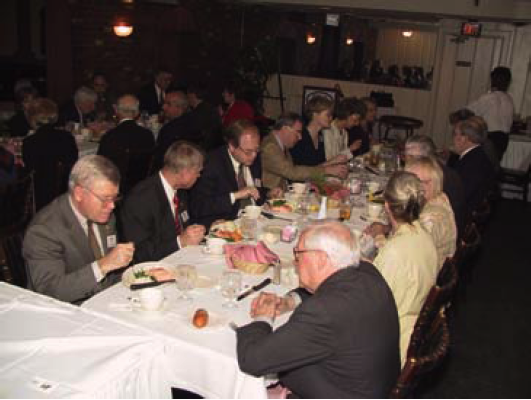
Guests at first FDAAA luncheon, including Dr. Lester Crawford (foreground left)
Villforth touted the concept of an association, updated those in the room on the organization’s size (50 or so members from 10 states) and praised FDA and Schwetz for their overwhelmingly positive support. Despite an abbreviated appearance because of an important meeting at the White House to which he had been summoned at the last minute, Crawford was obviously impressed.
Attended by over 40 persons, the inaugural luncheon had gone well. Standing in for Crawford as keynote speaker, Schwetz reiterated for the crowd what he had said repeatedly in private from from day one to Villforth and others: having alumni experience and expertise at close range would be of inestimable benefit to FDA. Quite simply, Schwetz said, FDAAA was organization that had his attention and ardent support and he vowed to see to it that an equal measure of support was forth-coming from Crawford.
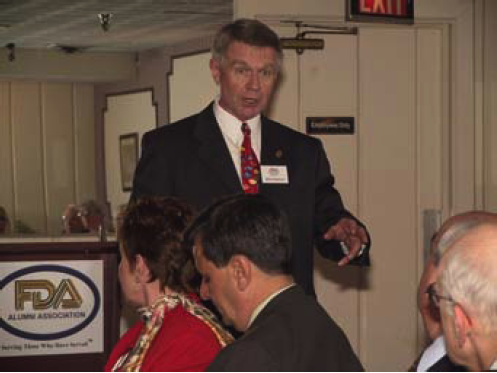
Dr. Bern Schwetz addresses first FDAAAA luncheon gathering
In Villforth’s thinking, Crawford’s appearance, although brief, bode well for the future of FDAAA’s negotiations on a working agreement. In the back of Villforth’s mind, the critical link to the SAA’s success was the unwavering support it received from the NIST leadership. He wanted for FDAAA the same type of certain relationship with his former agency and was prepared to work hard to get Crawford to feel the way Schwetz did. In some respects, he thought, winning over Crawford might be a bit easier because the two knew each other well from their days in the 1970’s as fellow bureau directors on FDA’s Policy Board. Hopeful that their past relationship and the positive sentiments expressed at the luncheon, Villforth banged out a letter to Crawford raising the possibility of in-kind assistance from the agency to help FDAAA get up and running.
Gaining Legitimacy Though Legal Status
The actual birthing of FDAAA occurred on July 15 when, following acclimation by formal balloting by the steering committee, Greenberg filed incorporation papers and by-laws to the State of Maryland Department of Assessments and Taxation. As required, the documents listed the association’s first-ever cadre of officers.
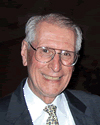
John Villforth
Chairman of the Board
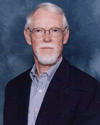
Burton Love
Vice Chairman and President
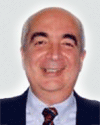
Joseph Arcarese
Treasurer
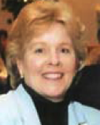
Kelly Sauer
Secretary
Bruce Kuhlik
General Counsel
In addition, the filed papers named an initial Board of Directors, divided into three “classes” to insure orderly succession following expiration of three-year rotational terms.
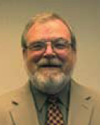
Ronald Chesemore
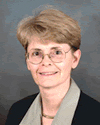
Elizabeth Krell
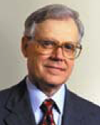
Paul Parkman
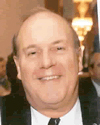
Robert Sauer

Burton Love
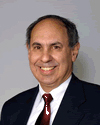
Wayne Pines
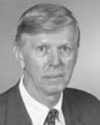
John Vanderveen
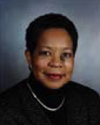
Sharon Smith Holston
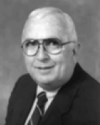
Gerald Meyers
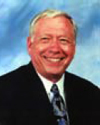
Arthur Norris

John Villforth
Class I: Ronald Chesemore, Elizabeth Jacobson, Paul Parkman, Robert Sauer
Class II: Burton Love, Wayne Pines, John Vanderveen
Class III: Sharon Smith Holston, Gerald Meyer, Arthur Norris, John Villforth
With a few exceptions, the initial field of FDAAA leaders was enlisted from the pool of people who served on the steering committee. Their induction, in effect, marked the termination point for the steering committee and a formal hand-off of fiduciary responsibilities to the new team. The task immediately before them was straightforward: launch the organization and get people to join.
Within the week, control over the association’s rather meager finances (about $900) was transferred from McClean to Arcarese. Solvency aside, FDAAA was at least a legal corporation and, in many respects, had plenty going for it. The ability to expand membership and give the new organization solid financial footing boiled down to persuasive salesmanship and a credible and substantive corporate business plan that clearly would benefit public health and the FDA.
More, somewhat mixed news followed a short time later regarding the working agreement with FDA. HHS lawyers had come around in their thinking and had agreed to permit FDA to engage in a business relationship with an outside, non-profit organization like FDAAA. The not-so-good news was that the lawyers preferred that the two parties work together under the terms of a contract instead of a memorandum of understanding, as was originally planned. Why exactly the contract approach was preferable to an MoU wasn’t at all clear, but it struck association officials as problematic. Under a contract, many thought, FDAAA could be held to some absolute standard of performance which, if unmet, could jeopardize the association’s relationship with the agency. This was of particular concern as it related to the association’s long-term standing. Also, there were questions as to whether FDA could contract with FDAAA on a sole source basis or whether the association would face a competitive bidding process. People at FDA who Schwetz had appointed to work out a deal with FDAAA did their level best to assure Villforth and others that the HHS opinion was not the last word nor was it an insoluble problem.

Richard Merrill, former FDA General Counsel
Just four days later, on July 23, more news jolted the association. Kuhlik announced he was leaving his law firm and taking the job of general counsel at PhRMA, the principal trade group forthe pharmaceutical industry. Moving over to PhRMA and facing all the demands of a new, high-profile job, Kuhlik told Villforth, would prevent him from continuing as FDAAA’s chief attorney. As a result, the pair got in touch with Richard Merrill, a senior partner at Covington & Burling, who was also a law professor at the University of Virginia law professor and had previously served as FDA general counsel. They asked Merrill if he would consider immediately stepping in as Kuhlik’s successor. Merrill told them that he was interested but wanted more information. Villforth invited Merrill to meet with him, Arcarese and Eccleston. The four congregated early one evening in July at the Willard Hotel in downtown Washington. There, they discussed the association’s origins, goals and efforts to forge a working relationship with FDA. Merrill seemed persuaded but politely insisted on more time to think over how he might fit this work in with all his other responsibilities; on July 29, he accepted.
Breaking More Ground
On August 26, the Board of Directors (minus Merrill who had a prior engagement) met for the first time. Thanks to the offer of a suitable meeting place by an FDA alumnus who now worked at the drug company, Pfizer, the Board met at Pfizer’s Rockville office The marathon meeting produced

Front row (l to r): Bob Eccleston, Kelly Sauer, Burton Love, John Villforth, Sharon Holston, Heather Nevin Back row (l to r): Eric Greenberg, Wayne Pines, Ron Chesemore, Gerry Meyer, Bob Sauer, John Vanderveen, Joe Arcarese
a number of significant decisions. The go-ahead was given for Covington & Burling lawyers to file the IRS tax exempt application that Nevin, Arcarese, Eccleston and Kelly Sauer had completed. Best guesses then were that a decision from IRS could take upwards of a year. In the course of preparing the application, Nevin and her law firm associates raised questions about particular activities originally contained in the scope of the organization’s charter.
As she had done during the preparatory process, Nevin advised the Board that “social” functions in the eyes of the IRS were simply taboo and must be functions held for an educational purpose. The other proposed activity that raised eyebrows among the legal advisors was participation by FDAAA members in retirement counseling for FDA employees. Such an activity, Nevin told the Board, could be viewed as contributing to personal inurement, a violation of IRS’s rules governing non-profit organizations. The Board took Nevin’s observations to heart and ordered the necessary changes.
In recognition of their exceptional legal work, Villforth used the occasion to make a first-time presentation of FDAAA certificates of appreciation to Greenberg and Nevin.
Realizing the steering committee had essentially completed all its work, the Board then voted to disband it and establish in its place several standing committees: Finance, Membership, Activities and Communications. The four new committees joined the Executive Committee and Nominating Committee, already constituted by association by-laws. Additionally, as authorized by the by-laws, the Board officially appointed Eccleston as the first Associate Member Liaison to represent the interests of FDA employee members, leaving open the length of his service term. After much debate, the Board also gave approval to a dues structure -- $35 for Alumni Members, $20 for Associate Members-- with instructions to the Membership Committee to consider the option of “lifetime” memberships.
At the Board meeting, Directors received news that two commercial companies had offered pro bono assistance to help FDAAA get started. The first, the Cincinnati-based company, Kendle International, and its subsidiary, AAC Consulting Group, volunteered production support on the association’s newsletter, “Connections.” The Board appreciatively accepted Kendle’s offer. And, as a cost-saving measure, the Board also decided the quarterly publication should be made available to members via a secure access port on FDAAA’s website rather than having hard copies disseminated by mail. An editorial board, with Mr. Tony Celeste as editor-in-charge, was formed to ensure the newsletter and other association publications, met satisfactory content standards.
The second offer of outside help came from the Washington, DC public relations firm of Hill & Knowlton. The offer was communicated by its vice president, Donald McLearn, previously a public affairs chief at FDA, who volunteered the firm’s resident expertise on branding and mass marketing. While grateful for the offer, the Board demurred, saying it wanted more information before any commitment by either side was made.
Most on the minds of the people seated around the Board table was the pending agreement with FDA. Its in-limbo status had many worried and wondering whether the HHS stipulations could be overcome. Knowing the situation was totally outside the control of the association, Board members nonetheless expressed a desire for FDAAA leaders to exert whatever influence they could with Deputy Commissioner Crawford to induce him to intercede and break the apparent logjam.
As the meeting closed, the Directors collectively reflected on the year that had just passed. All were satisfied with the progress, noting that all the hard work and hours of volunteer participation was finally beginning to reap dividends. The FDAAA was indeed on its way to taking its place on the public stage.
Opening for Business
Five days before the one-year anniversary of the 9/11 tragedy, on September 6, FDAAA put on its second luncheon in downtown Rockville and introduced Dr. Andrea Meyerhoff, the agency’s new counterterrorism office director, as the featured speaker. Although still getting acclimated to her new job, Meyerhoff impressively outlined the mission of her office and shared some early strategic thinking that purportedly would guide her work and that of her staff. Recalling Schwetz’s oft-repeated claims of wanting to be able to tap alumni expertise at a moment’s notice when disaster struck and FDA was propelled into action, many in the audience realized this was a perfect opportunity for partnership with Meyerhoff. One by one, they urged the agency’s counterterrorism czar to factor FDAAA into her office operating plans because it represented a unique extramural resource she could reflexively leverage in times of national emergency.
Meyerhoff was quick to take note of the overture. In a matter of weeks, Pines and Marc Scheineson, an attorney and former associate commissioner for legislative affairs, opened a dialogue with Meyerhoff on precisely what role the association might play.
As with the preceding luncheon, this event provided an opportunity to recruit new members. As an added incentive, Villforth told the gathering, people who signed up then would forever be distinguished as charter members, The idea of charter memberships came from Jacobson’s Membership Committee and was adopted without hesitation by the Board. The special recognition meant, very simply, that first-time members enrolling through the end of 2003 would be regarded by the association as individuals who got in on the ground floor and whose early support was a cornerstone of the association. A number of people around the room took Villforth up on the offer.
In the weeks that followed, plans for the grand opening of the FDAAA shifted into high gear. The roll-out was scheduled for early 2003, although the exact time and place were undecided. As preparations moved ahead, a parade of FDA commissioners and acting commissioners, past And present, lined up behind the soon-to-be-announced organization. Enthusiastically, they Were responding to a letter request from Villforth in September 2002 for written endorsements in exchange for induction into the association as Distinguished Members. The first wave of respondents included Dr. Charles Edwards, Dr. Donald Kennedy, Mr. Sherwin Gardner, Dr. Mark Novitch, Dr. Jere Goyan, James Benson, Dr. Jane Henney and Dr. Michael Friedman, in addition to Drs. Schwetz and Crawford.

Donald Kennedy, Former FDA Commissioner
Written in his own hand, Kennedy’s endorsement perhaps said it best:
“I’m delighted that some of my former colleagues at FDA have decided to institutionalize our collective loyalty to the agency by creating the Food and Drug Administration Alumni Association. FDA has a wonderful institutional tradition of service, and -- along with many other alumni – I need ways of following its progress and its problems. Its success will send a message to others that we really care about the FDA and the public that benefits in so many ways.”
Subsequently, Dr. James Goddard, Dr. Frank Young, Dr. David Kessler and Dr. Mark McClellan followed suit. A short time later, Dr. Arthur Hull Hayes elected to join the association and, as Young had done, made a financial donation.
As details for FDAAA’s unveiling were being worked out, association officials made an all-out push to get FDA to reach closure on the issue of bilateral agreement. The pace of back-channel discussions picked up speed, with Bea Droke, Larry Tidmore, Bob Sauer, Meyer and Love hashing out lingering issues and wordsmithing the agreement language. Every one of them held out hope that a successful outcome was inevitable and the association would have an agreement it could showcase at its grand opening.
New Thrusts
On November 14, the Bush Administration appointed, and the Senate ultimately confirmed, a new, permanent FDA commissioner, Dr. Mark McClellan. Whether the 39-year old physician and medical economist would see the FDAAA in the same light as Schwetz and Crawford did was a total unknown. What remained a surety was Crawford’s steadfast support, evident in his keynote address at an wine-tasting and dinner event on November 16. Yet despite his reassurances and tireless efforts of people from FDA and FDAAA, the long-desired agreement remained elusive.
The Board congregated for a second time on November 25, again in Rockville. Topping the agenda was the status of the agreement negotiations. By invitation, Tidmore and Droke, surprisingly candid, told the Directors that the deal was regrettably still far from done, but hastened to add that they remained optimistic that something would eventually be worked out. All along, everyone on the Board knew intuitively that a commitment on paper from FDA was pivotal to FDAAA’s start-up success. The revelation by the guests brought momentary dejection in the meeting room, but quickly the Directors rebounded and implored Tidmore and Droke to engineer some resolution to the problem with HHS legal staff. With a common voice, individual Directors pressed the case for conditions that would allow FDA to accept advice-giving and technical support from FDAAA alumni volunteers as well as permit FDA employees to work on collaborative projects with the association during regular duty hours. Departing the meeting, the FDA team pledged to do their best.
The Board then moved on to other business. Dr. Mark Novitch and Tony Celeste, respectively, were installed as chairs of the Nominating and Communications Committees, a segue into the proposition to modify the still-fresh by-laws to enlarge the numerical composition of the Board to include the chairs of all standing committees. Proponents cited the experience of other organizations that they belonged to and insisted that making room for committee chairs would better guarantee informed policy and program discussions by the Board. Resisting the move, opponents claimed a larger Board would be unwieldy and vulnerable to having its deliberations getting bogged down. Because Directors were evenly divided, the matter was tabled.
While failing to agree on Board expansion, Directors unanimously approved the addition of a second Associate Member Liaison and selected Gail Sherman, an education specialist from CBER and a member of the Membership Committee, as a co-equal representative with Eccleston.
Distribution plans for the inaugural newsletter, due out in November 2002 and the public roll-out of the association, which included complimentary announcements and publicity by other organizations with ties or which are impacted by FDA, were given Board approval. The issues of lifetime memberships, member eligibility criteria and verification of applicant information were put on the back burner.
Just over a week after the Board meeting, some unexpected and welcome news came the association’s way. The IRS had granted provisional tax-exempt status through December 2006. The ruling was significant in several respects. First, it came much faster than the lawyers at Covington predicted. Second, having the imprimatur of IRS, many inside the association felt, would help allay concerns in FDA or HHS about striking a business relationship with an organization that was anything other than not-for-profit. And third, it made membership more enticing because the Association could advise prospective members that dues could be deducted on their federal tax returns.
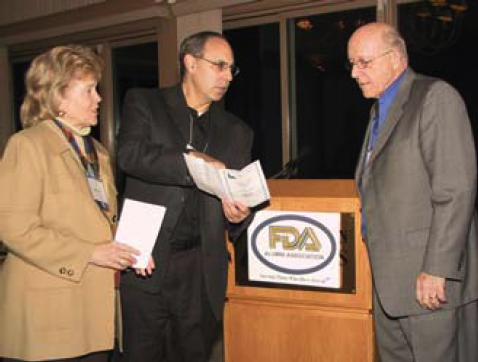
FDAAA hosts first annual wine-tasting and dinner event to celebrate year’s achievements; Kelly Sauer and Wayne Pines talk with event organizer and sommelier, Dr. Bert Mitchell (left) about the program
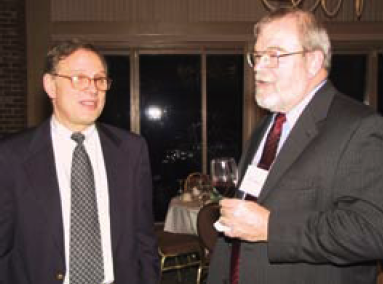
Phil Derfler (left) and Ron Chesemore enjoy the evening
Overall, much had been achieved in 2002. Nearly 100 people had signed up. A considerably larger number were showing genuine interest. That alone was a harbinger of an equally eventful 2003.
Chapter Three: Major Breakthroughs
As Villforth and other leaders waiting anxiously for final word on the agreement, the Membership Committee was able to enlist the Food and Drug Law Institute, Advamed (a major medical device trade group, and the Consumer Healthcare Products Association to help with promotion of the FDAAA.
Then, more shocking news came. Literally days before the next association luncheon, set for March 3, 2003, the breakthrough that everyone had long awaited, happened: with the blessing of HHS, FDA announced that a memorandum of understanding, not a contract, had been agreed to and was ready for signature. Even better, FDA officials informed the association that McClellan who was already booked as the luncheon’s headliner, would sign the document, alongside Villforth at the event. As word spread, a giant sigh of relief and buzz of euphoria could be felt throughout the association.

Mark McClellan Former Commissioner
“… one of my pleasures in getting in my first few months here has been to try to help the Alumni Association move its critical mission forward as best I can. I know you as a young organization, just founded a couple of years ago, but the mission of providing opportunities for alumni to – I know you like to say ‘give back’ to FDA -- but you gave a lot of service while you were here, and it’s something I hope and I know you are doing because you feel like your expertise can continue to contribute to our institutional knowledge and expertise and also to help us keep abreast FDA Commissioner Mark McClellan and keep you all informed about things that are going on at the agency.
Most of you are in positions where you have a significant influence of the way people think about what the FDA does: whether it’s from a position of retirement… from where you can talk informally… in many contexts about the FDA’s mission and activities or because you are still involved in a very formal way in some kind of job that has a direct relationship, or indirect relationship at least, to the FDA activities. This is a good mechanism for communication for us too.”
Continuing, McClellan hailed the Association as a critical resource for the agency.
“This Association is uniquely positioned to help out with… all the kind of priorities that I just mentioned as well as others that I haven’t had time to address. The membership of this organization potentially includes thousands of people who have not only helped the agency fulfill its mission over the years, but are also continuing in important positions of responsibility…” “… we need to do more to help us (FDA) benefit from your experience, wisdom and your willingness to provide some time and effort in continuing to help the agency fulfill its mission as effectively as possible.”
Then came the news everyone was waiting to hear, along with a general but daunting challenge.
“We are now today going to sign a Memorandum of Understanding which has been in the works for awhile and I want to thank everyone in this organization and those at FDA who’ve helped make this possible…” I do want to emphasize that we are putting you on the spot with this MoU. We did a bit of work to get this together. You did even more, and now I’m asking you all to do still more to make sure we take advantage of the opportunities that the MoU will set up.”
If any of the luncheon guests had doubts about McClellan’s commitment to the agreement, he dispelled them by announcing that would be his “point person on interactions with the Alumni Association.”
It was an acme moment he and Villforth signed the two-page agreement. The deal was finally done. With the stroke of a pen, FDA formally proclaimed its support for the association and authorized agency employees to work with FDAAA on joint initiatives in the course of their normal duties. The room erupted into applause which, a few minutes later, grew to a standing and sustained ovation as the commissioner, smiling, left the room and headed back to his Parklawn office.
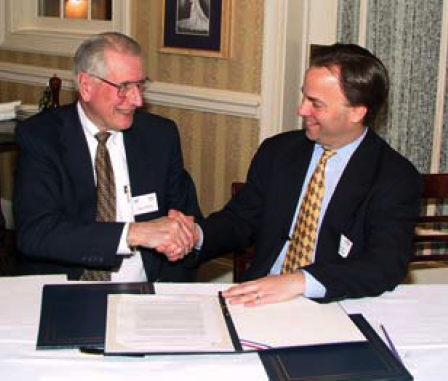
Villforth and McClellan after MoU signing
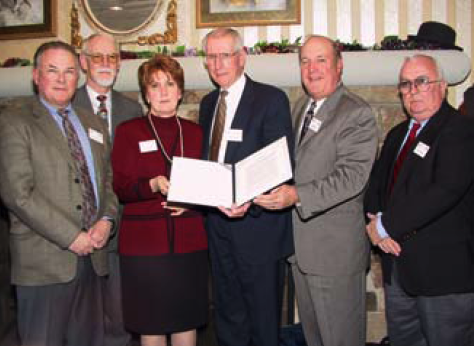
(L to r): Larry Tidmore (FDA), Burton Love, Bea Droke (FDA), John Villforth, Bob Sauer and Gerry Meyer proudly display FDA-FDAAA Memorandum of Understanding
To be sure, the agreement signing was a momentous achievement. Along with the legal act of incorporation and the IRS ruling, the association was now at long last whole, with a real sense of purpose. With but a month until FDAAA officially opened its doors, the coup de gráce, in the form of an MoU, couldn’t have been better timed.
Amid all the hoopla of the MoU signing, Villforth, Love and others paid serious heed to the commissioner’s challenge to get busy on positioning the agency to make full use of its relationship with FDAAA. Within days, small group from FDAAA sat down with staff from the commissioner’s office to plan the development of a database cataloguing alumni expertise that both parties could access at a moment’s notice in order to locate alumni with specialized knowledge and expertise. Concurrently, staff from Meyerhoff’s counterterrorism office and FDA’s international affairs office, led by Melinda Plaisier, were re-approached on cooperative ventures. FDA awards coordinators, having gotten word of the alumni association and MoU, invited FDAAA to play a central role in the nominations process for the agency’s prestigious Distinguished Alumni Award. Also proposed was joint sponsorship of a new award to recognize people who had made outstanding contributions to FDA’s mission but who had never worked for the agency.
The dramatic surge in momentum carried over to April when the public kick-off of the FDAAA occurred at FDLI’s annual educational conference in Washington, DC. FDLI President, Jerry Halperin, himself an FDAAA member, and McClellan touted the FDAAA in their conference-opening remarks. Their comments sparked immediate interest, resulting in a large portion of the over 600 FDLI conference attendees to flock around the association’s exhibit.
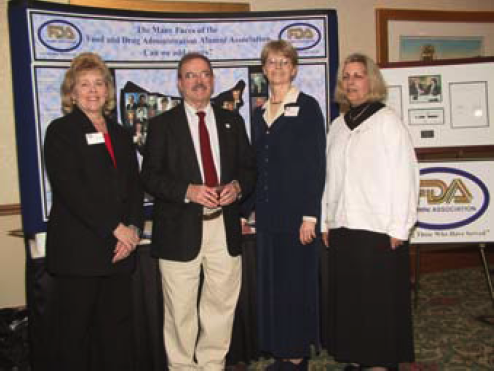
FDAAA exhibitors (l to r): Kelly Sauer, Ken Krell, Liz Jacobson and Gail Sherman
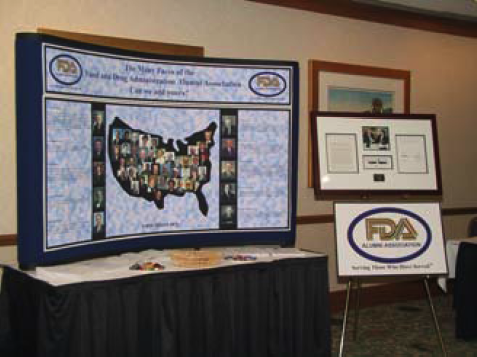
Exhibit unveiling FDAAA at FDLI annual meeting in 2003
At times, the crowd swelled to four, five and even six deep, and intensely curious and inquisitive about what FDAAA could offer them. In general, reaction was universally positive among both alumni and active employees. Immediately apparent, though, was that the association had a bit of an image problem. Employees, in particular, who read the association’s title on the exhibit banner instantly assumed that membership in FDAAA was restricted to “alumni.” Once it was made clear that the association’s doors were open to everyone, a substantial number eagerly joined.
At day’s end, 50 or more members and individuals interested in hearing more about the association gathered for what was billed as the initial annual meeting. Apart from the largely pro forma business of voting the Directors into office, the session was devoted to overviewing the organization and why it existed, as well as to a “group brainstorming” on what should be done to carry out its mission and how to cater to dues-paying members so, as “satisfied customers,” they could act as multipliers and help spread the word.
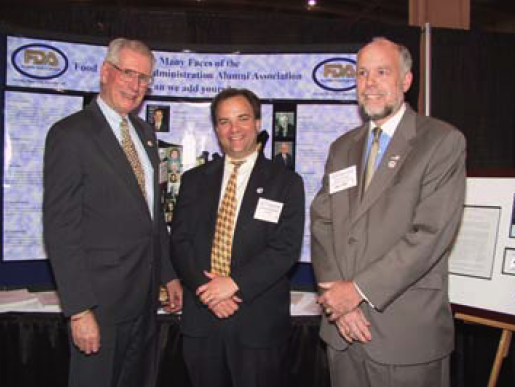
FDA Commissioner McClellan (center) with FDAAA co-founders John Villforth and Bob Eccleston
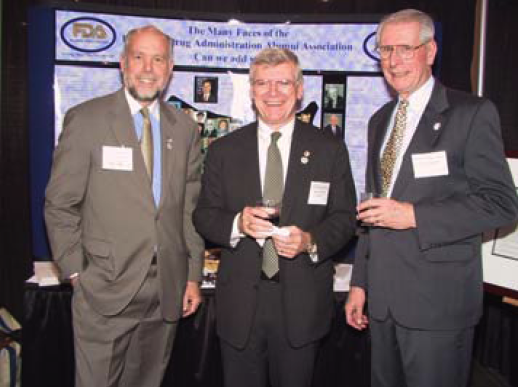
FDA Deputy Commissioner Crawford joins Eccleston and Villforth at FDAAA exhibit during FDA Science Forum
At the FDA Science Forum two weeks later at which FDAAA re-displayed its exhibit, reactions among the 2,000 participants were equally positive, perhaps the result of comments by McClellan just a day earlier during a live nationwide video broadcast to FDA employees. On the air, the commissioner, in response to a question from moderator, Mark Barnett, said:
“I just recently signed a Memorandum of Understanding with the FDAAA. This is a very exciting new agency that provides new opportunities for the many people who have been part of FDA to remain connected with the agency going forward. As they liked to tell me at that meeting where we signed the MoU: ‘once an FDAer, always an FDAer.’ And I think there really is a strong connection that many of the people feel who have left the agency feel. The FDAAA is going to provide opportunities for people who have left the agency to continue to offer their expertise and perspectives on our activities, and also I think will strengthen our ability to connect with the outside world and let them know about the important new activities that we’re working on that are tremendously vital for promoting the health of this country.”
Progress continued. On May 23, the first major installment of new member packets – nearly 275 in all – were mailed. In early June, Villforth, Love and Pines met again with Crawford and his aides to work out a plan for implementing the memorandum of understanding, as McClellan had directed. The deputy commissioner relegated the details of specific working arrangements to program heads, suggested an exchange of letters that identified the areas in which association members would or could play a supporting role and invited an introductory briefing by FDAAA leaders for the agency’s Executive Council as a way to stimulate ideas among the most senior managers on programs that could benefit from cooperative activities with the association. Crawford also picked up on Schwetz’s earlier promise to find a satellite office, outfitted with all the necessary business equipment, for FDAAA visitors.
The letter exchange, which honed in on international affairs, counterterrorism and outreach, were delivered to Crawford two days later. Crawford, in turn, delivered on his promise regarding office space. A dedicated office was reserved on the 11th floor of the Parklawn Building. He also reserved time at the Executive Council’s July 10 meeting (postponed until July 31) for the presentation to FDA senior staff. The briefing by Villforth, Love and Pines was well received and led to other actions by FDA to give tangible support to FDAAA, including an “all hands” e-mail from McClellan to the entire FDA workforce underlining his support and encouraging employees to give the organization a serious look.
By July, the membership rolls eclipsed the 300 mark, with people signing on from 26 U.S. states, Washington, DC, and even the country of Switzerland.
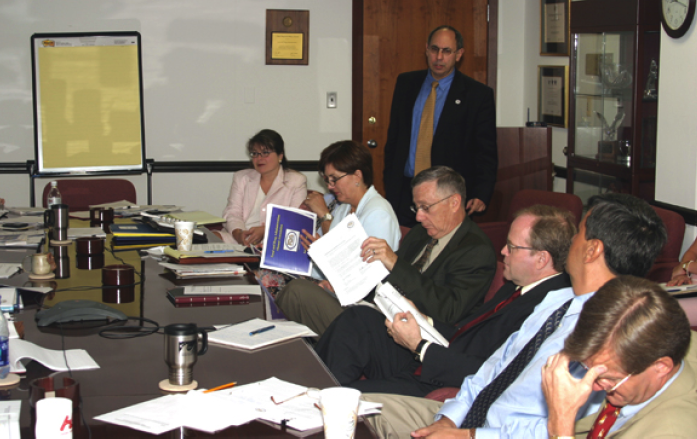
FDAAA Board Director Wayne Pines (standing) briefs FDA Executive Council on FDAAA mission
Soldiering On
Come the Fall, the Association was in full stride. Former acting commissioner and CDRH director, James Benson, agreed to spearhead both a new awards subcommittee and an ad hoc committee that would assist FDA in preparing for its centennial observance in 2006.
More FDAAA-sponsored events got scheduled, attracting new faces and many of the agency’s most senior policy-makers, among them Daniel Troy, FDA’s General Counsel, who spoke on the culture at FDA relating to regulatory enforcement, and Dr. Scott Gottlieb, Senior Advisor for Medical Technology, who took a long view of issues confronting FDA and how the agency was positioning itself to deal with them.
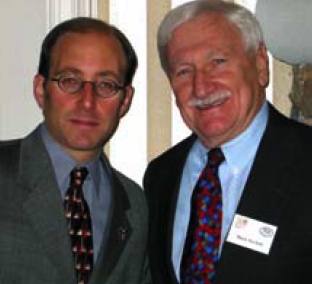
FDA General Counsel Dan Troy (left) with former Acting Commissioner Mark Novitch
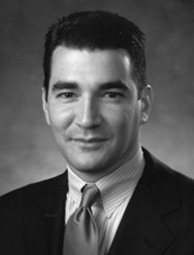
Dr. Scott Gottlieb
Some time later, Deputy Commissioner for Operations, Dr. Janet Woodcock, made a luncheon appearance as keynote speaker.
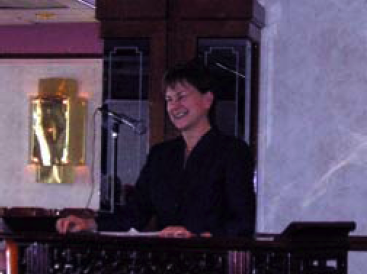
Dr. Woodcock addressing FDAAA luncheon guests
By the end of 2003, membership had surpassed 400. Expectations were riding high for an even larger run of enrollments the following year. In an effort to stay in more frequent touch with members, the organization’s renewal policy was changed such that a “rolling” quarterly renewal calls supplanted the existing calendar year schedule. A search was also begun for chair of the new Member Services Committee (replacing the original Membership Committee), as well as for replacements for Arcarese and Holston who signaled their desire to step down as Treasurer and Director, respectively.
Chapter Four: Fulfilling the Mission
Early in 2004, Halperin took the job of Treasurer. Holston’s resignation cleared the way for candidate nominations for her Board slot, including Benson who on an interim basis, had served out the remaining year of her term. Dr. Alan Andersen, a former senior scientist and manager at CDRH, was put in charge to work as head of the Member Services Committee. The committees got down to work, as did Benson’s ad hoc centennial committee which resulted in FDA naming the association a principal centennial co-sponsor.
News broke about the same time of President Bush’s decision to move McClellan from FDA to the HHS Centers for Medicare and Medicaid Services. By the end of March, despite threatened blockage of his confirmation to the new post because of FDA’s policy against U.S. consumer importation of cheaper prescription drugs from Canada, the sitting commissioner was confirmed for the new post, vaulting Crawford into the job of acting commissioner.
Despite all the upheaval, association managers focused their attention to getting ready for the organization’s annual meeting in April.
Establishing Traditions
On April 14, 2004 at the Loew’s L’Enfant Hotel in downtown Washington, DC, FDAAA held what many regarded as its first formal annual meeting. The over 80 people attended got an ssessment of the past year’s progress and a preview of the next year’s priorities. They also heard Acting Commissioner Crawford who gave his annual “State of the FDA” message. Those eligible to vote cast their ballots for a new slate of Directors after which the audience was introduced to the next year’s contingent of officers and other Association leaders.
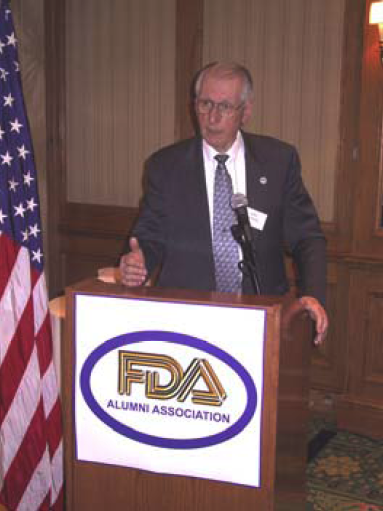
Chairman Villforth reporting on FDAAA’s progress to annual meeting attendees
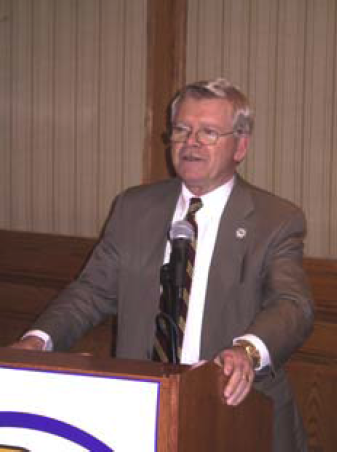
Dr. Lester Crawford talks about FDA’s agenda and how FDAAA can help
The meeting also saw the start of a yearly tradition: presentation of the Harvey W. Wiley Lecture. Paul Rogers, a distinguished and well-known member of the U.S. House of Representatives from Florida, whose committee leadership greatly impacted FDA and other U.S. health agencies, was honored as the inaugural Lecturer and inducted as FDAAA’s first Honorary Member.
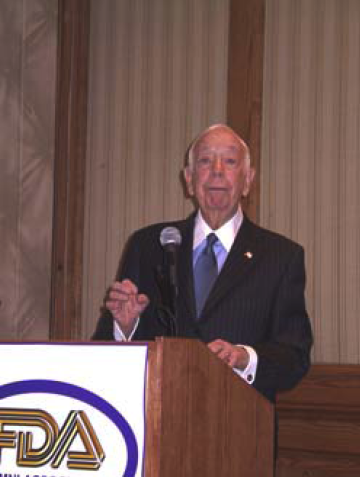
Paul Rogers delivers inaugural Harvey Wiley Lecture
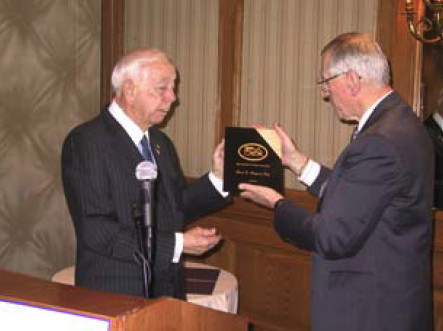
after which he receives first Wiley Lecture plaque from FDAAA Chairman John Villforth
Another tradition was started with the Volunteer of the Year Award. For his pioneering work as an association co-founder and his exemplary service as FDAAA’s first Treasurer, Joe Arcarese, was the first recipient of the new award.
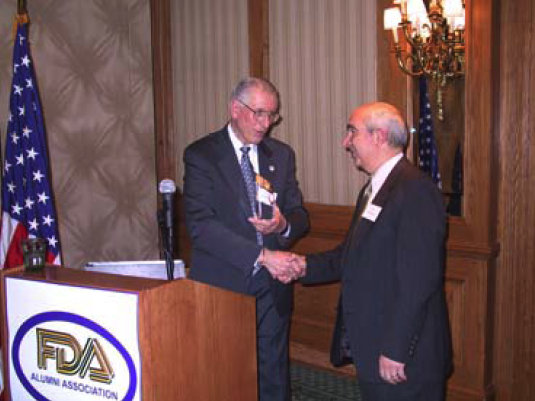
Joe Arcarese accepts FDAAA Volunteer of the Year Award from John Villforth
From that date onward, events steadily shaped FDAAA’s growth curve. A major step forward occurred in August when, by invitation from FDA and the Department of Health and Human Services, Love traveled to the Kingdom of Jordan with a team of regulatory experts and international health officials from both agencies. An exploratory visit, resulting from talks between HHS Secretary Tommy Thompson and the Jordanian Health Minister, was arranged as a regulatory expertise-sharing relationship, primarily in the areas of pharmaceutical regulation and laboratory quality assurance. The goal was to establish an ongoing technical and training consultation in which association alumni ould have an integral part. The role carved out for FDAAA was a breakout one that would forever set the tone and direction of the organization.
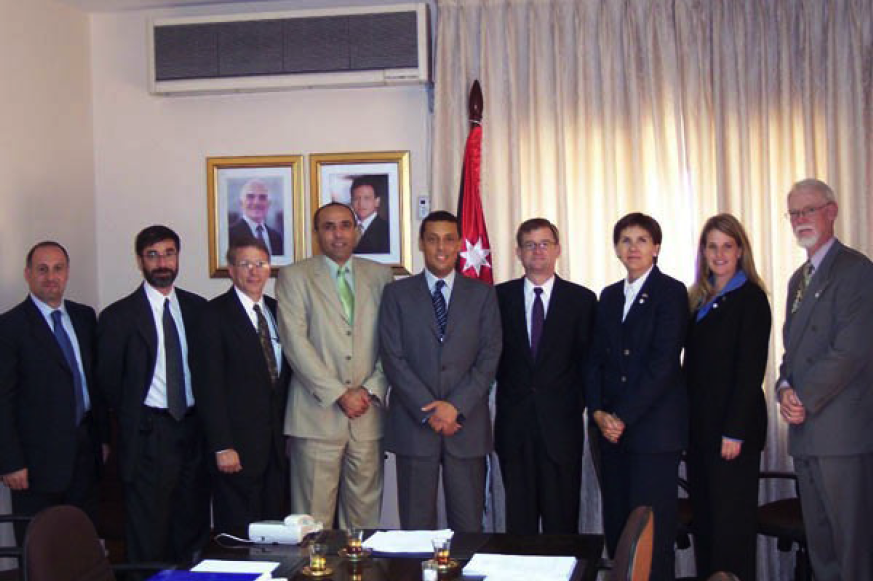
US and Jordanian FDA delegations, including FDAAA’s Burton Love (far right), meet in Amman to discuss technical working relationship
End Note
What began as a far-reaching -- some might even say altruistic -- idea four years earlier had finally come of age. The long journey of advancing an idea, getting others to embrace and support it, and crystallizing concepts into action was at last seeing results. In the time that followed, the association would make more significant strides, increasing its public profile and enhancing its utility. All was made possible by one simple truth: once an FDAer, always an FDAer.
To this day, the journey continues.
